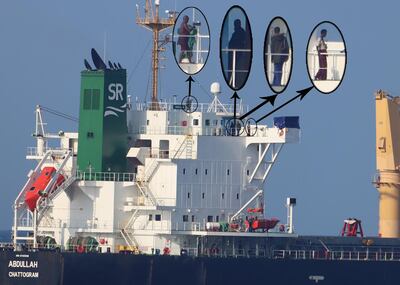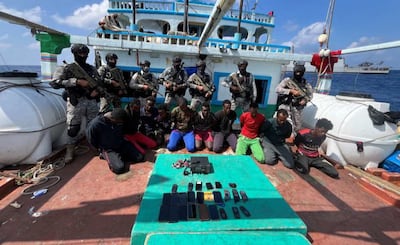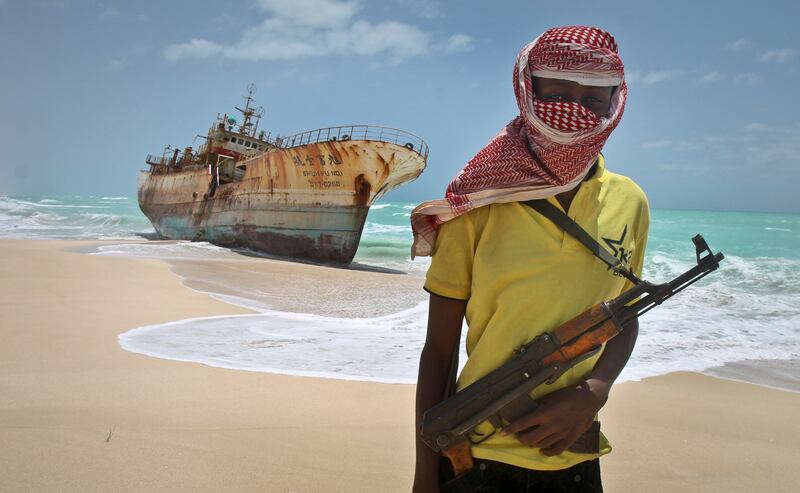Somali pirates are hijacking merchant ships in the “target-rich” waters of the Indian Ocean after hundreds of vessels diverted south to avoid the Houthi attacks in the Red Sea.
Shipping organisations have told The National that much greater co-ordination is needed between Nato, European Union, Indian and Chinese warships in the area to halt the piracy that created crippling costs for businesses a decade ago.
There is also a suspicion that Iran might be funding the increase in attacks to cause more disruption to western economies and divert warships away from its Houthi allies.
Target-rich environment
The Houthi missile and drone attacks on shipping going through the Red Sea has reopened a potential new source of revenue for the Somali pirates,
The attacks have caused a 40 per cent drop in Red Sea cargo and a surge in shipping taking the three-week longer route via the southern tip of Africa and the Indian Ocean.
“This is a more target-rich environment for any pirate,” said John Stawpert, of the International Chamber of Shipping. “The intelligence is quite hazy as to exactly what their intent is and whether these are just probing attacks or whether there's something bigger going on.”
The pirates now have more ships to choose from, said Ben Manzin, a shipping intelligence analyst at the Sibylline security company.
“They are exploiting the vulnerability and chaos created by the Houthis and this is now presenting quite a significant threat to the shipping that that is going south.
“This has created a moment where, maybe these Somali have thought there is some space for us to re-engage in this activity with a large number of targets and because everyone is looking further north, leaving these seas more vulnerable.”
UAE seizure
Earlier this month, 1,000km off the Somali coast, 20 gunmen seized the MV Abdullah that was taking coal from Mozambique to the UAE.
That followed a rise in piracy off the Horn of Africa since November last year which saw three merchant ships targeted and 18 dhows hijacked.
There are now concerns that Somali piracy is resurgent, potentially making the waters off the Horn of Africa once again the most dangerous in the world.
At its peak in 2011 there were 212 attempted hijacks with $53 million paid in ransom cash in a crisis that also cost an estimated $18 billion to world trade.
It was only after navies across the globe co-ordinated a significant armada that piracy petered out, with many Somalis tried and locked up.

Iran funding?
There has been a degree of sophistication in the actions of the pirates, who use mother ships then small attack boats to board vessels far out in the Indian Ocean.
It has been suggested the Somalis might have received funding from Iran for their operations in order to draw western warships away from patrolling the Red Sea.
“Iran could be using yet another vehicle to stoke the situation and divert resources,” said retired commander Tom Sharpe, formerly of the Royal Navy. “It would not be hard for them to start funding elements of the original Somali pirates.”
Their aim would be to disrupt freedom of navigation in order to “drain Western resources”.
He also questioned whether all the pirates were Somali with a suggestion that some might be Yemenis, further underlining the Iran connection, as Tehran supports the Houthis.
He added that the surge in shipping had also seen a growth in piracy off the Gulf of Guinea on the other side of the African continent.

Indian navy success
However, the pirates suffered a setback when the Indian navy conducted a highly successful operation earlier this month by retaking the MV Ruen and rescuing its crew after it was hijacked in December.
But an international coalition of navies needs to establish firm communications to co-ordinate against both the piracy and Houthi attacks, said Mr Stawpert, whose organisation represents 80 per cent of the main global shipping organisations.
With Nato, EU, Indian and Chinese warships in the Red Sea, Gulf of Aden and Indian Ocean “we have more grey hulls [warships] down there than we’ve ever had”, he said.
If the various flotillas “keyed into one another at a tactical level” that would give them “maximum flexibility” to respond to the threat.
“Then if it's the Houthis or if it's a Somali pirate attacking you, you can be reassured that there will be a military response,” he added.






